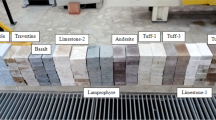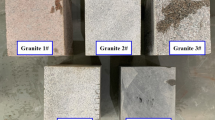Abstract
This paper presents an experimental and statistical study on the kerf width, used instead of the width of the cut in abrasive waterjet (AWJ) cutting. Pre-dimensioned granitic rocks were sampled for the experimentations designed by using Taguchi orthogonal arrays. The effects of the AWJ operating variables on the kerf width were studied and the rock properties were correlated with the kerf widths. Additionally, predictive models for the kerf widths were developed using multi-variable regression analysis and the developed models were verified through some statistical tests. The results demonstrated that the standoff distance and the traverse speed have significant effects on the kerf widths. The results also showed that water absorption, unit weight, microhardness, the maximum grain size of rock-forming minerals, and mean grain size of the rock have significant correlations with the kerf widths of the tested rocks. Furthermore, the modeling results revealed that the predictive models derived from rock properties, can be successfully used as a practical guideline.




Similar content being viewed by others
References
Atici U, Ersoy A (2009) Correlation of specific energy of cutting saws and drilling bits with rock brittleness and destruction energy. J Mater Process Tech 209:2602–2612
Aydin G, Karakurt I, Aydiner K (2011) An investigation on the surface roughness of the granite machined by abrasive waterjet. B Mater Sci 34(4):985–992
Bayram F (2012) Prediction of sawing performance based on index properties of rocks. Arab J Geosci. doi:10.1007/s12517-012-0668-5
Brook N, Summers DA (1969) The penetration of rock by high-speed water jets. Int J Rock Mech Min 6(3):249–258
Chakravarthy SP, Babu RN (1999) A new approach for selection of optimal process parameters in abrasive water jet cutting. Mater Manuf Process 14(4):581–600
Chakravarthy PS, Babu AR, Babu NR (1998) A fuzzy based approach for selection of process parameters in abrasive waterjet cutting of black granite. In: Proc. of 5th Pacific Rim International Conference on Water Jet Technology, New Delhi, India, pp 108–120
Chen L, Siores E, Wong WCK (1996) Kerf characteristics in abrasive waterjet cutting of ceramic materials. Int J Mach Tool Manu 36(11):1201–1206
Chung Y, Geskin ES (1992) Prediction of the geometry of kerf created in the course of abrasive waterjet machining of ductile materials. 11th. International Conference on Jet Cutting Technology, Scotland, pp 525–541
Ciccu R, Grosso B (2010) Improvement of the excavation performance of PCD drag tools by waterjet assistance. Rock Mech Rock Eng 43:465–474
Cortes MRG, Lauand TC, Hennies TW (2003) Waterjet researches at São Paulo University: Part 3 waterjet methods of cutting dimensional Stone; Proceedings of American Waterjet Conference, Houston, Texas, paper, 4-C
Engin CI (2012) A correlation for predicting the abrasive water jet cutting depth for natural stones. S Afr J Sci 108(9/10):1–11
Engin CI, Bayram F, Yasitli EN (2012) Experimental and statistical evaluation of cutting methods in relation to specific energy and rock properties. Rock Mech Rock Eng. doi:10.1007/s00603-012-0284-4
Hlavac LM, Hlavacova IM, Gembalova L, Kalicinsky J, Fabian S (2009) Experimental method for the investigation of the abrasive water jet cutting quality. Int J Mater Process Tech 209(20):6190–6195
Huang ZC, Hou GR, Wang J, Feng XY (2006) The effect of high pressure abrasive water jet cutting parameters on cutting performance of granite. Key Eng Mater 304–305:560–564
ISRM (1981) Rock characterization testing and monitoring suggested methods. In: Brown ET (ed) Pergamon, 1981, pp 211
Karakurt I, Aydin G, Aydiner K (2012) An experimental study on the cut depth of the granite in abrasive waterjet cutting. Mater Manuf Process 27:538–544
Kim GJ, Song JJ, Han SS, In Lee C (2012) Slotting of concrete and rock using an abrasive suspension waterjet system. KSCE J Civ Eng 16(4):571–578
Lauand TC, Martin RG, Hennies TW, Agus M (2001) Performance of waterjet cutting system in dimension stone; Proceedings of 11th. American Water jet Conference, Minneapolis, Minnesota, pp 427–449
Mikaeil R, Ataei M, Yousefi R (2013) Correlation of production rate of ornamental stone with rock brittleness indexes. Arab J Geosci 6:115–121
Miranda MR, Quintino L (2005) Microstructural study of material removal mechanisms observed in abrasive waterjet cutting of calcareous stones. Mater Charact 54(4–5):370–377
Miranda MR, Lousa P, Miranda MJA, Kim T (1993) Abrasive waterjet cutting of Portuguese Marbles; Proceedings of 7th American Water jet Conference, Seattle, Washington, pp 443–457
Nik GO, Sadrzadeh M, Kaliaguine S (2012) Surface grafting of FAU/EMT zeolite with (3-aminopropyl)methyldiethoxysilane optimized using Taguchi experimental design. Chem Eng Res Design 90(9):1313–1321
Nikonov GP, Goldin YA (1972) Coal and rock penetration by fine continuous high pressure water jets. In: Proc. 1st. International Symposium on Jet Cutting Technology, BHRA Fluid Engineering, Cranfield, UK, E2, 16 pages
Ozcelik Y, Bayram F, Yasitli EN (2013) Prediction of engineering properties of rocks from microscopic data. Arab J Geosci. doi:10.1007/s12517-012-0625-3
Pon Selvan CM, Raju SMN (2011) Assessment of process parameters in abrasive waterjet cutting of granite. International Conference on Trends in Mechanical and Industrial Engineering (ICTMIE’2011) Bangkok, pp 140–144
Sengun N, Altindag R (2012) Prediction of specific energy of carbonate rock in industrial stone cutting process. Arab J Geosci. doi:10.1007/s12517-011-0429-x
Shanmugam KD, Masood HS (2009) An investigation on kerf characteristics in abrasive waterjet cutting of layered composites. J Mater Process Tech 209:3887–3893
Tahernejad MM, Khalokakaie R, Ataei M (2013) Determining proper strategies for Iran’s dimensional stone mines: a SWOT–AHP analysis. Arab J Geosci 6:129–139
Vasconcelos G, Lourenço BP, Alves ACS, Pamplona J (2007) Prediction of the mechanical properties of granites by ultrasonic pulse velocity and schmidt hammer hardness. North American Masonry Conference, St. Louis, pp 980–991
Vundavilli RP, Parappagoudar MB, Kodali SP, Benguluri S (2012) Fuzzy logic-based expert system for prediction of depth of cut in abrasive water jet machining process. Knowl Based Syst 27:456–464
Xiaohong L, Jiansheng W, Yiyu L, Lin Y, Huiming K, Jiajun S (2000) Experimental investigation of hard rock cutting with collimated abrasive water jets. Int J Rock Mech Min 37:1143–1148
Xie J, Tamaki J (2007) Parameterization of micro-hardness distribution in granite related to abrasive machining performance. J Mater Process Tech 186:253–258
Acknowledgments
The authors would like to express their sincere thanks and appreciation for the financial support to TÜBİTAK (The Scientific and Technological Research Council of Turkey) (Project No 108 M370).
Author information
Authors and Affiliations
Corresponding author
Rights and permissions
About this article
Cite this article
Karakurt, I., Aydin, G. & Aydiner, K. An investigation on the kerf width in abrasive waterjet cutting of granitic rocks. Arab J Geosci 7, 2923–2932 (2014). https://doi.org/10.1007/s12517-013-0984-4
Received:
Accepted:
Published:
Issue Date:
DOI: https://doi.org/10.1007/s12517-013-0984-4




